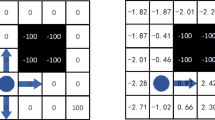Abstract
The Vanilla Reinforcement Learning algorithm for path planning in a 2-D world suffers from high mean path length and large iterations to optimize its path. An approach involving multi agents sharing common knowledge of the world has been simulated to improve the results. Multi agents increase the exploration area of the map without affecting the explore–exploit dilemma. Keeping in mind that in the real world agents may have vision, a simple yet effective vision-based technique has been proposed where an agent can locate its goal if it lies in its line of sight and not blocked by obstacles. An environment is designed in Python 3 that uses dynamically generated maps of different sizes to simulate the results.
Access this chapter
Tax calculation will be finalised at checkout
Purchases are for personal use only
Similar content being viewed by others
References
Masehian, E., Sedighizadeh, D.: Classic and heuristic approaches in robot motion planning—A chronological review. Proc. World Acad. Sci. Eng. Technol. 101–106 (2007)
Xianyi, Y., Meng, M.: A neural network approach to real-time motion planning and control of robot manipulators. Proc. IEEE/SMC 4, 674–679 (1999)
Yang, B., Li, W., Wang, J., Yang, J., Wang, T., Liu, X.: A novel path planning algorithm for warehouse robots based on a two-dimensional grid model. https://doi.org/10.1109/ACCESS.2020.2991076
Zheng, T., Xu, Y., Zheng, D.: AGV path planning based on improved A-star algorithm. In: Proceedings of the IEEE 3rd Advanced Information Management, Communicates, Electronic and Automation Control Conference (IMCEC), pp. 1534–1538 (2019)
Bae, H., Kim, G., Kim, J., Qian, D., Lee, S.: Multi-robot path planning method using reinforcement learning. Appl. Sci. 9, 3057 (2019)
Sichkar, V.N.: Reinforcement learning algorithms in global path planning for mobile robot. In: 2019 International Conference on Industrial Engineering, Applications and Manufacturing (ICIEAM), pp. 1–5 (2019). https://doi.org/10.1109/ICIEAM.2019.8742915
Butyrev, L., Edelhäußer, T., Mutschler, C.: Deep reinforcement learning for motion planning of mobile robots (2019). arXiv:1912.09260
Jiang, J., Dun, C., Huang, T., Lu, Z.: ICLR 2020 (2020)
Author information
Authors and Affiliations
Editor information
Editors and Affiliations
Rights and permissions
Copyright information
© 2022 The Author(s), under exclusive license to Springer Nature Singapore Pte Ltd.
About this paper
Cite this paper
Bhuiya, A., Satapathy, S.C. (2022). Improvements to Vanilla Implementation of Q-Learning Used in Path Planning of an Agent. In: Bhateja, V., Tang, J., Satapathy, S.C., Peer, P., Das, R. (eds) Evolution in Computational Intelligence. Smart Innovation, Systems and Technologies, vol 267. Springer, Singapore. https://doi.org/10.1007/978-981-16-6616-2_24
Download citation
DOI: https://doi.org/10.1007/978-981-16-6616-2_24
Published:
Publisher Name: Springer, Singapore
Print ISBN: 978-981-16-6615-5
Online ISBN: 978-981-16-6616-2
eBook Packages: Intelligent Technologies and RoboticsIntelligent Technologies and Robotics (R0)




